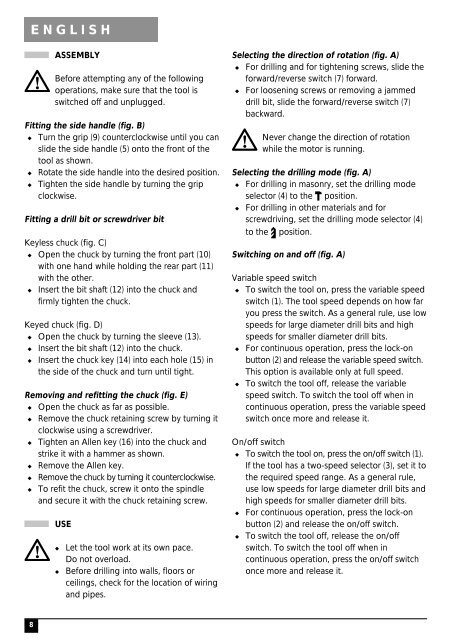BlackandDecker Perceuse- Kr532 - Type 1 - Instruction Manual
BlackandDecker Perceuse- Kr532 - Type 1 - Instruction Manual
BlackandDecker Perceuse- Kr532 - Type 1 - Instruction Manual
You also want an ePaper? Increase the reach of your titles
YUMPU automatically turns print PDFs into web optimized ePapers that Google loves.
ENGLISH<br />
ASSEMBLY<br />
Before attempting any of the following<br />
operations, make sure that the tool is<br />
switched off and unplugged.<br />
Fitting the side handle (fig. B)<br />
◆ Turn the grip (9) counterclockwise until you can<br />
slide the side handle (5) onto the front of the<br />
tool as shown.<br />
◆ Rotate the side handle into the desired position.<br />
◆ Tighten the side handle by turning the grip<br />
clockwise.<br />
Fitting a drill bit or screwdriver bit<br />
Keyless chuck (fig. C)<br />
◆ Open the chuck by turning the front part (10)<br />
with one hand while holding the rear part (11)<br />
with the other.<br />
◆ Insert the bit shaft (12) into the chuck and<br />
firmly tighten the chuck.<br />
Keyed chuck (fig. D)<br />
◆ Open the chuck by turning the sleeve (13).<br />
◆ Insert the bit shaft (12) into the chuck.<br />
◆ Insert the chuck key (14) into each hole (15) in<br />
the side of the chuck and turn until tight.<br />
Removing and refitting the chuck (fig. E)<br />
◆ Open the chuck as far as possible.<br />
◆ Remove the chuck retaining screw by turning it<br />
clockwise using a screwdriver.<br />
◆ Tighten an Allen key (16) into the chuck and<br />
strike it with a hammer as shown.<br />
◆ Remove the Allen key.<br />
◆ Remove the chuck by turning it counterclockwise.<br />
◆ To refit the chuck, screw it onto the spindle<br />
and secure it with the chuck retaining screw.<br />
USE<br />
◆<br />
◆<br />
Let the tool work at its own pace.<br />
Do not overload.<br />
Before drilling into walls, floors or<br />
ceilings, check for the location of wiring<br />
and pipes.<br />
Selecting the direction of rotation (fig. A)<br />
◆ For drilling and for tightening screws, slide the<br />
forward/reverse switch (7) forward.<br />
◆ For loosening screws or removing a jammed<br />
drill bit, slide the forward/reverse switch (7)<br />
backward.<br />
Never change the direction of rotation<br />
while the motor is running.<br />
Selecting the drilling mode (fig. A)<br />
◆ For drilling in masonry, set the drilling mode<br />
selector (4) to the position.<br />
◆ For drilling in other materials and for<br />
screwdriving, set the drilling mode selector (4)<br />
to the position.<br />
Switching on and off (fig. A)<br />
Variable speed switch<br />
◆ To switch the tool on, press the variable speed<br />
switch (1). The tool speed depends on how far<br />
you press the switch. As a general rule, use low<br />
speeds for large diameter drill bits and high<br />
speeds for smaller diameter drill bits.<br />
◆ For continuous operation, press the lock-on<br />
button (2) and release the variable speed switch.<br />
This option is available only at full speed.<br />
◆ To switch the tool off, release the variable<br />
speed switch. To switch the tool off when in<br />
continuous operation, press the variable speed<br />
switch once more and release it.<br />
On/off switch<br />
◆ To switch the tool on, press the on/off switch (1).<br />
If the tool has a two-speed selector (3), set it to<br />
the required speed range. As a general rule,<br />
use low speeds for large diameter drill bits and<br />
high speeds for smaller diameter drill bits.<br />
◆ For continuous operation, press the lock-on<br />
button (2) and release the on/off switch.<br />
◆ To switch the tool off, release the on/off<br />
switch. To switch the tool off when in<br />
continuous operation, press the on/off switch<br />
once more and release it.<br />
8
















